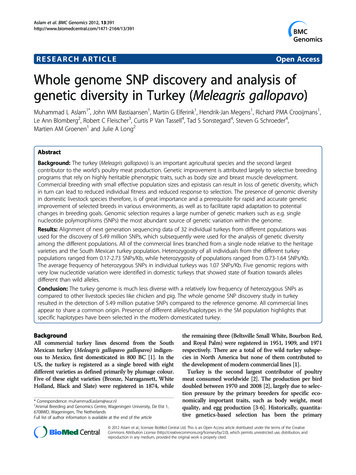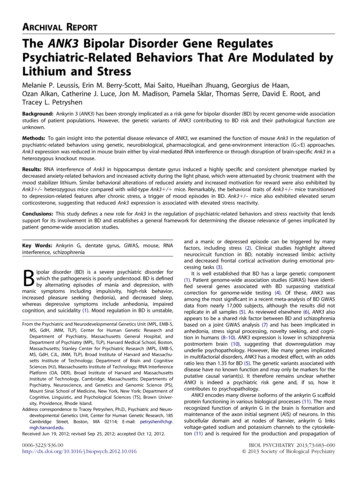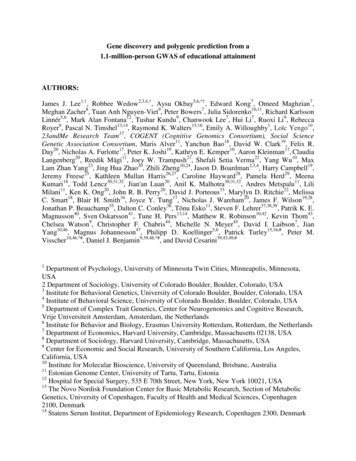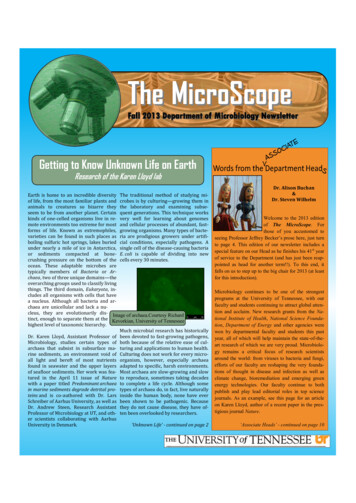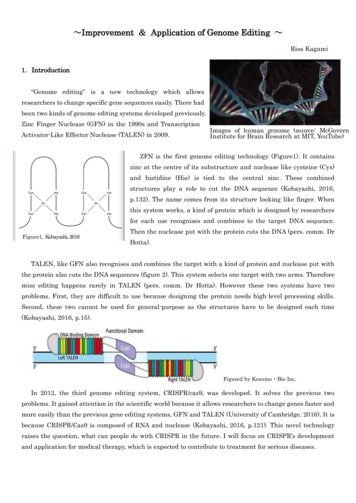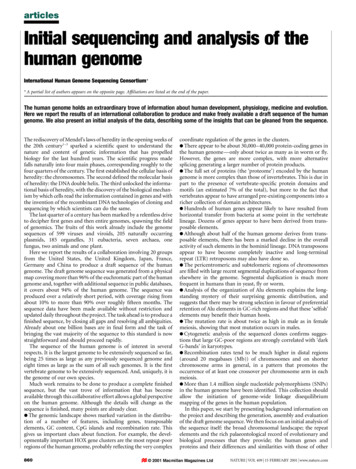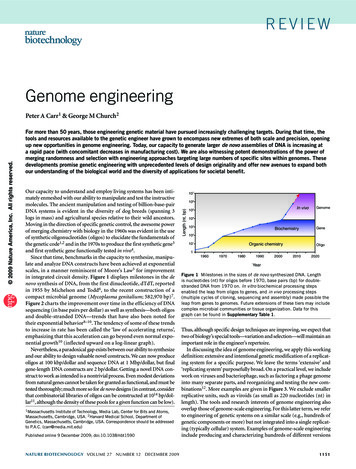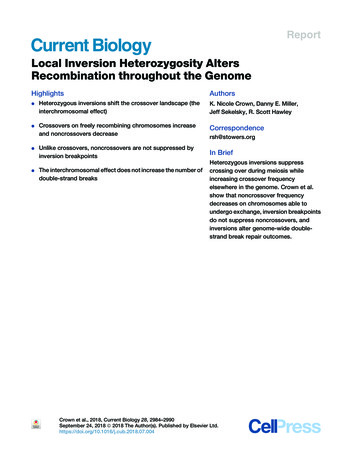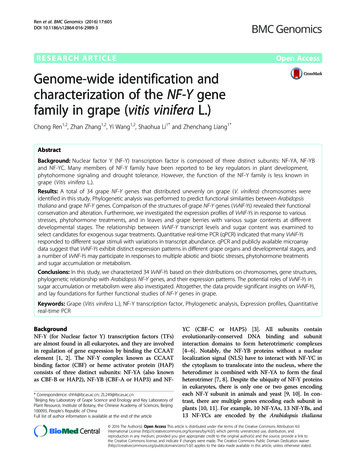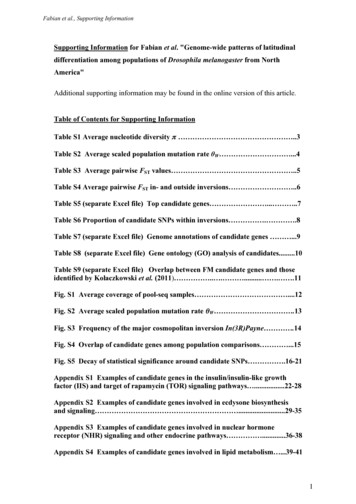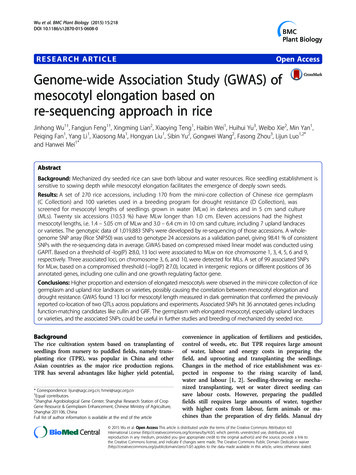
Transcription
Wu et al. BMC Plant Biology (2015) 15:218DOI 10.1186/s12870-015-0608-0RESEARCH ARTICLEOpen AccessGenome-wide Association Study (GWAS) ofmesocotyl elongation based onre-sequencing approach in riceJinhong Wu1†, Fangjun Feng1†, Xingming Lian2, Xiaoying Teng1, Haibin Wei1, Huihui Yu3, Weibo Xie2, Min Yan1,Peiqing Fan1, Yang Li1, Xiaosong Ma1, Hongyan Liu1, Sibin Yu2, Gongwei Wang2, Fasong Zhou3, Lijun Luo1,2*and Hanwei Mei1*AbstractBackground: Mechanized dry seeded rice can save both labour and water resources. Rice seedling establishment issensitive to sowing depth while mesocotyl elongation facilitates the emergence of deeply sown seeds.Results: A set of 270 rice accessions, including 170 from the mini-core collection of Chinese rice germplasm(C Collection) and 100 varieties used in a breeding program for drought resistance (D Collection), wasscreened for mesocotyl lengths of seedlings grown in water (MLw) in darkness and in 5 cm sand culture(MLs). Twenty six accessions (10.53 %) have MLw longer than 1.0 cm. Eleven accessions had the highestmesocotyl lengths, i.e. 1.4 – 5.05 cm of MLw and 3.0 – 6.4 cm in 10 cm sand culture, including 7 upland landracesor varieties. The genotypic data of 1,019,883 SNPs were developed by re-sequencing of those accessions. A wholegenome SNP array (Rice SNP50) was used to genotype 24 accessions as a validation panel, giving 98.41 % of consistentSNPs with the re-sequencing data in average. GWAS based on compressed mixed linear model was conducted usingGAPIT. Based on a threshold of -log(P) 8.0, 13 loci were associated to MLw on rice chromosome 1, 3, 4, 5, 6 and 9,respectively. Three associated loci, on chromosome 3, 6, and 10, were detected for MLs. A set of 99 associated SNPsfor MLw, based on a compromised threshold ( log(P) 7.0), located in intergenic regions or different positions of 36annotated genes, including one cullin and one growth regulating factor gene.Conclusions: Higher proportion and extension of elongated mesocotyls were observed in the mini-core collection of ricegermplasm and upland rice landraces or varieties, possibly causing the correlation between mesocotyl elongation anddrought resistance. GWAS found 13 loci for mesocotyl length measured in dark germination that confirmed the previouslyreported co-location of two QTLs across populations and experiments. Associated SNPs hit 36 annotated genes includingfunction-matching candidates like cullin and GRF. The germplasm with elongated mesocotyl, especially upland landracesor varieties, and the associated SNPs could be useful in further studies and breeding of mechanized dry seeded rice.BackgroundThe rice cultivation system based on transplanting ofseedlings from nursery to puddled fields, namely transplanting rice (TPR), was popular in China and otherAsian countries as the major rice production regions.TPR has several advantages like higher yield potential,* Correspondence: lijun@sagc.org.cn; hmei@sagc.org.cn†Equal contributors1Shanghai Agrobiological Gene Center; Shanghai Research Station of CropGene Resource & Germplasm Enhancement, Chinese Ministry of Agriculture,Shanghai 201106, ChinaFull list of author information is available at the end of the articleconvenience in application of fertilizers and pesticides,control of weeds, etc. But TPR requires large amountof water, labour and energy costs in preparing thefield, and uprooting and transplanting the seedlings.Changes in the method of rice establishment was expected in response to the rising scarcity of land,water and labour [1, 2]. Seedling-throwing or mechanized transplanting, wet or water direct seeding cansave labour costs. However, preparing the puddledfields still requires large amounts of water, togetherwith higher costs from labour, farm animals or machines than the preparation of dry fields. Manual dry 2015 Wu et al. Open Access This article is distributed under the terms of the Creative Commons Attribution 4.0International License (http://creativecommons.org/licenses/by/4.0/), which permits unrestricted use, distribution, andreproduction in any medium, provided you give appropriate credit to the original author(s) and the source, provide a link tothe Creative Commons license, and indicate if changes were made. The Creative Commons Public Domain Dedication o/1.0/) applies to the data made available in this article, unless otherwise stated.
Wu et al. BMC Plant Biology (2015) 15:218seeding can save water, but are labour costing. Somechanized dry seeding is probably the most efficientway of rice seedling establishment, saving 30 % labourthan machine-transplanting rice (MTPR) as estimatedin Korean trials [3].In rainfed areas or areas of inadequate irrigation,transplanting rice could completely fail or delay in yearswith less and/or delayed rainfall. As an example, a minimum of 600 mm of cumulative rainfall was required tocomplete field puddling and transplanting of rice in thePhilippines, much higher than 150 mm cumulative rainfall required by dry seeding [4]. In 1 year of every 4 years,a delay of 20 days for dry seeding could happen, muchshorter than 40-day delay for transplanting [5]. MDSRhas been widely adopted and will expand to much largerarea if effective managements are available to controlweeds and to maintain uniform plant density, e.g. finetillage, better land levelling, more appropriate seedplacement, improved nutrient application, varieties withhigher seedling vigor and lodge resistance [6]. So far, theappropriate techniques are not fully available yet toensure the perfect seedling establishments.Rapid and well seedling establishment is important forweed competitiveness and good harvesting of DSR, determined by sowing depth and a few other factors. Theseedling establishment and shoot dry weight were critically affected by the depths of soil and water layer in lowland wet seeded rice [7]. Hanviriyapant et al. reportedthe well establishment and strong seedlings of a tall,vigorous-growing cultivar and higher sensitivity of semidwarf cultivar to sowing depth and time of sowing afterirrigation [8]. An experiment of gradient sowing depthsshowed that the seedling establishment of wheat was notaffected by sowing depths from 2.3 to 8.3 cm, butdeclined to about 6 % at 14.3 cm [9].Elongation of both mesocotyl and coleoptile can facilitate the seedling establishment of rice when sown deep insoil or under water layer [10, 11]. Mgonja et al. reportedthe association between mesocotyl elongation and seedling vigor [12]. Alibu et al. found that coleoptile lengthwas more enhanced under submergence while mesocotylelongated more in soil-sand culture. Sown 8 cm deep, theemergence of only a few genotypes was determined byvaried mesocotyl elongation, not the variation of coleoptilelengths [13], similar to an early observation in indica rice[14]. Mesocotyl elongation has been found to be the causeof deep-seeding tolerance in maize [15, 16].Mesocotyl elongation has been measured in severalsets of germplasm, e. g. 128 weedy rice or Korean cultivars [11], 27 diverse cultivars [17], near 100 rice accessions [18] and 1500 accessions [19]. Low percentage ofrice germplasm has highly elongated mesocotyl (e. g.longer than 1.0 cm). Genetic analysis showed that mesocotyl length had high heritability [17], but was controlledPage 2 of 10by different genetic effects [20, 21]. Linkage mappingfound 3–8 QTLs for mesocotyl length of rice seedlingsin different populations [22–27]. Two QTLs on ricechromosome 1 and 3 were repeatedly detected andshowed large effects across different experiments.Genome-wide association study (GWAS) based on SSR[28] or single nucleotide polymorphism (SNP) markers[29–33] has been widely used in model plant species including rice. Extremely high resolution can be achieved bydense SNPs identified in diverse germplasm panels basedon the 2nd generation genome sequencing or SNP arrayapproaches [29–35]. In this study, GWAS based on resequencing approach was conducted in a set of rice landraces or varieties for mesocotyl elongation as a key character enhancing rice seedling emergence, especially after dryseeding with relatively higher sowing depth.ResultsPhenotypic variations of mesocotyl elongation amongrice germplasm accessionsA wide range of mesocotyl lengths in different ricegermplasm accessions, from almost no elongation to amaximum of 5.05 cm, were observed in the dark germination experiment. Mesocotyl length varied fromnearly zero to a maximum of 2.05 cm among those riceaccessions when measured in 5 cm sand culture.ANOVA showed highly significant variance among ricegermplasm accessions, together with less or no significant variance between replications for ML in dark germination with water (MLw) and ML in sand culture(MLs) (Table 1).As shown in Fig. 1, only a low proportion of germplasm accessions had largely elongated mesocotyl. TheMLw of 26, 29 and 192 accessions were higher than1.0 cm, in the range of 0.5–1.0 cm and shorter than0.5 cm, respectively. MLs showed similar general trendwith MLw, but had some deviation around MLw (Fig. 1).The mesocotyl lengths measured in dark germination(MLw) and in sand culture (MLs) had highly significantcorrelation (r 0.784**; Additional file 1: Table S1).Table 1 ANOVA of mesocotyl length of rice seedlings in darkgermination in water (MLw) or 5 cm sand culture (MLs)TraitsSourcesDfMLw (cm)Line246Rep1MLs (cm)SSMSF valueP 79004.9500
Wu et al. BMC Plant Biology (2015) 15:218Fig. 1 Varied mesocotyl lengths among rice landraces or varieties,measured in seedlings from dark germination in water (MLw) or5 cm sand culture (MLs)A third experiment was conducted to confirm previous results and to check the reaction of mesocotylelongation to higher depth of sand or soil coveringlayers, using 30 landraces or varieties representing accessions with low, medium and high mesocotyl elongation.As sorted by MLw on the axis of abscissa (Fig. 2),ascending lines showed consistent trends between themeasurements of mesocotyl lengths in all experiments.The seedlings had similar mesocotyl lengths in eithersand or soil culture. The reaction of mesocotyl elongation to two seeding depths showed different patternsamong rice accessions. The first 10 accessions (on theleft in the chart) had almost same mesocotyl lengths forboth depths, i.e. no more increase under 10 cm sandculture as a more favoured condition, implying that themeasurements here represented the maximum capacityof mesocotyl elongation of those accessions. Another 10Page 3 of 10accessions (in the middle) had a little longer mesocotyllengths under 10 cm than under 5 cm covering layers,suggesting their maximum capacity up to 2.5–3 cm thatwas equivalent to or a little higher than the detectablelimit in experiment of 5 cm sand or soil culture. For thelast 10 accessions, mesocotyl lengths were higher in10 cm than in 5 cm depth. It is obvious that those landraces or varieties had capacities of mesocotyl elongationfrom 3 to 6 cm, fully expressed in 10 cm, but not in5 cm culture. The low measurements (2–3 cm) in 5 cmsand or soil culture were perhaps the result of lightinhibition after the emergence of coleoptiles or leaves ofthe seedlings.Eleven rice accessions, TAINUNG 67, HAOGANG,YUNLU 8, BAYUENUO, IR65907-116-1-B, MOWANGGUNEI, HAOHAI, IAC1246, MAGUZI, ZHONGNONG4 and ZAXIMA, possessed high mesocotyl lengths in allexperiments, i. e. 1.4 – 5.05 cm in dark germination and3.0 – 6.4 cm in 10 cm soil or sand culture. Among them,seven accessions were upland landraces (HAOGANG,MOWANGGUNEI, HAOHAI and ZAXIMA) or uplandvarieties (YUNLU 8, IR65907-116-1-B and IAC1246).SNP validation and population structure analysisA subset of 24 accessions, including 9 from C collectionand 15 from D collection, were genotyped using theRiceSNP50 whole-genome SNP array [31]. There are10,851 SNP loci shared by the genotypic data sets fromre-sequencing SNP calling and SNP array. Each accession has effective data on 8,313–10,746 common SNPloci after excluding loci with missing data in either SNPcalling or array. The accuracy of SNP calling and missingFig. 2 Mesocotyl lengths of 30 rice germplasm accessions measured in sand or soil culture with two seeding depths
Wu et al. BMC Plant Biology (2015) 15:218genotype imputation, represented by the percentage ofconsistent SNPs in total number of common loci,reached 98.41 % in average and ranged from 97.01 to99.53 % for each accession (Additional file 2: Table S2).The population structure was estimated using a subsetof 144,995 SNP loci with less than 10 % missing data inD collection before imputation (as the total SNP numbercalled from the sequencing reads of the accessions in the Dcollection is much lower than that in the C collection).Using genotypic data before imputation could avoid thepossible influence from imputed values on genetic distanceand LD levels. A two sub-population structure, highlymatching the two subspecies in rice, was observed amongthose accessions in this study (Fig. 3; Additional file 3:Figure S1). Among 4 aus accessions, DULAR and N22were grouped into indica while AUS 454 and LAMBAYEQUE into japonica subpopulation.Genome-wide association study (GWAS)Forward model selection procedure provided the largestBayesian information criteria (BICs) for both traits whenzero PCs/covariates were included in the GWAS models(Additional file 4: Table S3). This result suggested thatthe PCs estimated from SNP data had weak covariancewith the phenotypic data. Using -log(P) 8.0 as thethreshold at a significant level of 0.01 after Bonferronimultiple test correction, a total of 13 loci were declaredto have highly significant association with the mesocotyllengths (MLw). Those associated loci were located on 6chromosomes of rice, including 3, 3, 1, 2, 2, 2 loci onchromosome 1, 3, 4, 5, 6 and 9, respectively (Fig. 4a).Seven peaks with -log(P) values larger than 10 in Manhattan plot indicated very strong signals of associationbetween the trait and the chromosomal regions, especially four regions on chromosome 3, 5, 6 and 9 whichhost sharp -log(P) peaks.Page 4 of 10The Manhattan plot of MLs shows totally differentpattern (Fig. 4b). Only three associated SNPs were detected at the significant level of -log(P) 8.0, includingtwo SNPs locating in the same regions associated toMLw on chromosome 3 and 6, one SNP on chromosome 10 with no association to MLw.As Bonferroni correction was recognized to be too conservative [36], a compromised threshold of –log(P) 7.0was used to screen out a set of 99 SNPs associating toMLw and 7 SNPs to MLs (Additional file 5: Table S4).Among MLw associated SNPs, 52, 16, 24, 3, 3, 1 SNPslocated in intergenic regions, intron, promoter, CDSsynonymous, CDS-nonsynonymous and 5′ UTR regionsof 36 annotated genes, respectively. Two MLs associatedSNPs hit the promoter region of LOC Os03g40390 whileanother SNP and the remaining four SNPs located in theintron of LOC Os10g20860 and the intergenic regions,respectively.In about 15.7Kb interval (29288539-29304267) on ricechromosome 1, five MLw associated SNPs located in thepromoter, CDS-nonsynonymous or intergenic regions ofthree putative genes (LOC Os01g50970, LOC Os01g50980, LOC Os01g50990). Those genes have been annotated as expressed protein with unknown function,putatively expressed cullin and FBD domain containingprotein, respectively. One associated SNP (0430137498)located in the promoter of rice gene LOC Os04g51190,annotated as a growth-regulating factor.DiscussionRetrieving the character of mesocotyl elongation todevelop varieties for mechanized dry seeded riceIn the past several decades, many labour-saving methodsof seedling establishment have been developed andwidely used in rice production in Asian countries wherehand transplanting rice became common during 1950–Fig. 3 Neighbor joining tree of 270 rice accessions showed a two-subpopulation structure in consistence with the classification of indica (in red)and japonica (in blue) subspecies. Four aus accessions (in green) were grouped into two subpopulations
Wu et al. BMC Plant Biology (2015) 15:218Page 5 of 10Fig. 4 Manhattan plots of genome-wide association mapping for mesocotyl lengths measured in dark germination with water (MLw, a) and in5 cm sand culture (MLs, b) and Quantile-Quantile plots for MLs (c) and MLs (d)70s. Among them, mechanized dry seeded rice (MDSR)is probably the system using the least water and labourresource [3–5]. As the majority of modern rice varietieswere developed for transplanting system in irrigated environments, their performance has not been optimizedfor direct seeding, especially in drought-prone environments. Early maturing, high-yielding rice varieties thatcan withstand drought and compete with weeds are urgently required in the dry-seeded rice system. In thiscase, well establishment and vigorous growth of the riceseedlings become very important [4].In order to obtain quick and uniform seedling emergence, shallow sowing with a narrow range of depth (e.g.2–3 cm) is required in drill seeding for most semidwarfrice varieties. Seedling establishment decreases remarkably, together with the delayed seedling emergence andpoor early growth, when seeding depth is higher than5 cm [3]. But shallowly sown seeds are vulnerable to birddamage while the derived plants are possibly sensitive tolodging at late stage [36]. In drought prone areas, thequick lost of moisture in shallow soil layer would causedelayed or failed seed germination and seedling emergence. This is the major reason why the period frompre-irrigation to sowing has critical influence on seedlingestablishment of DSR [8]. Narrow tolerant range of seeding depth will cause high risk of inadequate managementin mechanized seeding if the soil was not finely tilledand levelled or the seed drill did not give precise seedplacement. So rice varieties with tolerance to variedseeding depth, would reduce such kind of risk or additional requirements to farm machinery, then facilitatethe expanding of mechanized dry seeded rice.An early observation confirmed the association ofmesocotyl elongation with seedling vigor in rice [12] anda wide range of genetic variation of this trait among ricegermplasm [11, 13, 17–19], even though the percentageof germplasm with mesocotyl length higher than 1.0 cmwas low, e.g. less than 1 % in a set of 1500 accessions [19].In this study, 26 accessions had mesocotyl length (MLw)higher than 1.0 cm, showing much higher percentage(10.53 %) than previous reports (Fig. 1). Among 11 accessions with most elongated mesocotyl in this study, thereare 7 upland accessions (4 landraces and 3 varieties), accounting for a quite high proportion. Larger genetic variation could be expected in core or mini-core collection ofgermplasm. And it seems reasonable that more uplandrice accessions have highly elongated mesocotyl [18].A few publications described the failed emergence ofsemidwarf rice varieties and/or the successful emergence of tall, vigorously growing varieties when sowndeep [8, 10]. It should be true that most modern ricevarieties, developed for transplanting cultivation, havelost the character of mesocotyl elongation. But an important question is whether mesocotyl elongation istightly linked to plant height. Mgonja et al. found nocorrelation between mesocotyl elongation and characters of mature plants like plant height and internodelength L1 [20]. In this study, the same set of rice accessions were evaluated in field for drought resistanceusing water regimes (data not shown). Both MLw andMLs are correlated to plant height in both conditions(r 0.250 0.349; P 0.01; Additional file 1: Table S1);correlated to grain yield and spikelet fertility in droughttreatment, but not in well watered condition. These
Wu et al. BMC Plant Biology (2015) 15:218results did not necessarily indicate the linkage or pleiotropism of loci controlling mesocotyl elongation andplant height or drought resistance. It is more likely theconsequences of the high proportion of upland landraces or varieties in the population which had longermesocotyl, higher plant height and drought resistanceat the same time. So development of semidwarf varietiespossessing both mesocotyl elongation and drought resistance is necessary for mechanized dry seeded rice andachievable by using those potential germplasm screenedin this study.Mesocotyl elongation QTLs and candidate genesAmong 3–8 QTLs for mesocotyl length reported indifferent mapping populations [22–27], two QTLs (qMel1, qMel-3) on rice chromosome 1 and 3 were repeatedlydetectable and showed large effects across experiments[22–24, 26, 27, 37]. Substitution mapping confined qMel1 into a 3,799Kb interval from RM5448 to RM5310 andqMel-3 into a 6,964Kb region from RM3513 to RM1238,containing 490 and 700 putative genes, respectively [27].In this study, one SNP marker at the bottom of chromosome 1 was associated with MLw (P 2.57E-09), about0.17 Mb away from the interval of RM5448-RM5310.Strong association signals were detected in qMel-3 regionrepresented by the sharp -log(P) peaks in the Manhattanplots for both MLw and MLs (Fig. 4), including 3 SNPswithin a 50 Kb region. The positions of those associatedSNPs were not within, but about 2.59 Mb beyond theinterval between RM3513 and RM1238. If confirmed infurther studies like candidate gene cloning, the resultsdemonstrate the high power of GWAS based on highdense SNPs.The threshold of genome-wide association test using alarge number of SNP markers remains an issue undercontroversy. Nakagawa suggested that both standard andadjusted Bonferroni procedures should be abandonedbecause of reduced statistical power [38]. Controlling offalse discovery rate (FDR) was introduced by Benjamini[39] and recommended as a better statistical referenceto set the threshold of associated loci. In this study, bothP values and FDR adjusted P values showed similareffect in locating loci if referring to the peaks of significance above –log(P) 6 or –log(FDR adjusted P) 3(Additional file 6: Figure S2A). In general, log(FDRadjusted P) values increased as –log(P) values did(Additional file 6: Figure S2B). However, log(FDRadjusted P) values remained unchanged around 3while –log(P) varied from 6 to 7. Declared at the thresholdof –log(FDR adjusted P) 3, the number of associatedSNPs, 401 for MLw, seems too large. So a compromisedthreshold at –log(P) 7 were used to select significantSNPs (99 for MLw; 7 for MLs). Forty seven SNPs locatedin different positions of 36 annotated genes (itional file 5,Page 6 of 10Table S4). Among them, one cullin gene and OsGRF3 hadputative functions related to growth regulation. Cullinproteins was found as part of the scaffolds of multiple E3ligase [40], including the E3 ubiquitin ligase SCFTIR1 thatmediates ubiquitination of auxin/IAA proteins [41]. Thefirst growth regulating factor gene (OsGRF1) was identified as a transcript factor in rice, responding to gibberellin(GA) and showing potential regulatory role in stemgrowth [42]. Choi et al. [43] analyzed the expression patterns of OsGRF1 and its 11 homologs in the rice genome.Seven genes showed induced expression by GA3. Almostall OsGRF genes had high expression in primary leavesand the highest node containing shoot apical meristem or intercalary meristem and part of the elongation zone. As a candidate gene hit by the associatedSNP in our study, OsGRF3 was the only GRF genethat had strong level of expression in mesocotyls andcoleoptiles.ConclusionsHigher proportion and extension of mesocotyl elongation were observed in a population of landraces andvarieties from the mini-core collection of Chinese ricegermplasm and a collection of parental varieties fordrought tolerant rice breeding. High proportion of upland rice accessions within those having top mesocotyllengths (7 of 11 accessions) could be the cause of thecorrelation between mesocotyl elongation and droughtresistance, implying the important role and reservation of this character in upland rice germplasm.GWAS found 13 loci for mesocotyl length measuredin dark germination that confirmed the previously reported co-location of two QTLs across populationsand experiments. Associated SNPs hit 36 annotated genesincluding putatively function-matching candidates likecullin and GRF. The germplasm with elongated mesocotyl,especially upland landraces or varieties, and the associatedSNPs could be useful in further studies and breeding ofmechanized dry seeded rice.MethodsRice germplasm and phenotypic experimentsThe materials used in this study consisted of two sets ofrice germplasm. One is part of the mini-core collectionof Chinese rice germplasm, provided by Huazhong Agricultural University and China Agricultural University(170 accessions, denoted as C Collection) [33, 44] and aset of varieties collected for the breeding program ofwater-saving and drought -resistant rice (WDR) [45] byShanghai Agrobiological Gene Center (100 accessions,denoted as D Collection) (Additional file 7: Table S5).Two experiments were conducted to measure themesocotyl length of rice seedlings grown in water (MLw,cm) in darkness or under 5 cm sand layer (MLs, cm) for
Wu et al. BMC Plant Biology (2015) 15:21810 days. In each of two replications of the dark germination experiment, 20 seeds of each accession were sterilized with 3 % H2O2 solution, rinsed by tap water threetimes, submerged in water for pre-soaking by 24 h. Thenseeds were put on one layer of filter paper above asponge sheet in a plastic box with cover (L W H 12 12 2 cm). The boxes were kept in darkness incarton boxes that were placed in the incubator with constant temperature of 25 C. The mesocotyl lengths of fivenormal seedlings from each box were measured usingrulers.The sand culture experiments had two replicationsthat were arranged with 3d interval to allow quick finishof the measurements in each replication. Stainless steelboxes without bottom (L W H 90 30 30 cm)were placed on a levelled sand bed. After adding 5 cmsand layer, 12 seeds from each accession were placed onsand surface in a single row (about 2 cm apart betweenseeds) along the width of the box. The space betweentwo rows is about 5 cm. Another 5 cm sand layer wasadded over the seeds and saturated with water by sprinkleruntil leaking from the bottom of the boxes. Mesocotyllengths of 10 seedlings were measured using rulers afterall seedlings were taken out from the sand and washed bywater. This experiment was conducted in late May to earlyJune in a green house. The air temperature was within therange from 20 to 38 C while the temperature in sandlayer ranged from 20 to 31 C. There were 247 accessionsthat had effective phenotypic data of both MLw and MLsafter removing accessions with missing data caused byinadequate seed samples or failed germination in oneexperiment or both experiments.Thirty accessions, including those with longest MLwand a few accessions with low or moderate mesocotylelongation, were used in an additional experiment tocheck the mesocotyl elongation when seeds germinatedunder 5–10 cm layers of sand or soil. This experimentwas conducted using the same boxes and procedure asdescribed above, but setting two depth of cover layerand using dry soil as another medium.ANOVA and Pearson’s correlation analysis with twotailed significance were conducted using SPSS v16.0.Genotyping by re-sequencing and SNP validationWhole genome re-sequencing was conducted for twogermplasm sets using Solexa Hiseq 2000 system. Accessions in the C Collection and D collection werere-sequenced for 2.5 and 5 average genome coverage, respectively. The same pipelines with similarparameters [33], using the softwares BWA, SAMtoolsand BCFtools [46, 47], were used to call SNPs fromsequencing reads for both collections using the ricereference genome of Nipponbare (MSU Rice GenomeAnnotation Project Release 6.1) [48, 49]. A mergedPage 7 of 10genotypic data set was built by obtaining the intersectional loci of the two SNP data sets from C and Dcollections. Imputation procedure was conducted byusing FillGenotype program (Filling missing genotype(Fimg), http://www.ncgr.ac.cn/fimg/intr.html) based onK-nearest neighbor (KNN) algorithm, using the default parameters (w 80, p 7, k 5, and f 0.7)[29]. For the whole set of germplasm, the final genotypic data consists of 1,019,883 SNP loci.In order to evaluate accuracy of SNP calling and imputation pipeline, a high-density whole-genome SNParray, RiceSNP50 [34], was used to genotype a validationpanel of 24 accessions including 9 from C collection and15 from D collection. DNA amplification, fragmentation,chip hybridization, single base extension, staining andscanning were conducted by Life Science and TechnologyCenter, China National Seed Group Co., LTD (Wuhan,China), according to Infinium HD Assay Ultra Protocol(http://www.illumina.com/). The RiceSNP50 array contains about 51K evenly distributed SNP markers [34].About 43K SNPs with high quality were used in thecomparison with the SNP calls from re-sequencing.The percentages of consistent SNP loci were calculated by dividing the number of identical SNPs by theeffective SNP number within the common set of SNPloci (n 10,851) between array and SNP calls fromre-sequencing (Additional file 2: Table S2).Population structure analysis and genome-wide associationmappingBased on a subset of 144,994 SNPs that had less than10 % missing data in D Collection (with much lower totalSNP number than in C collection) before imputation, weused the Dnadist program to generate a pairwise distancematrix that was used to construct the unrooted and unweighted neighbour-joining tree by the Neighbor programfrom the software PHYLIP (V3.695, ml) [50]. The exported phylogenetic tree in Newick format was mo
or varieties. The genotypic data of 1,019,883 SNPs were developed by re-sequencing of those accessions. A whole-genome SNP array (Rice SNP50) was used to genotype 24 accessions as a validation panel, giving 98.41 % of consistent SNPs with the re-sequencing data in average. GWAS based on compressed mixed linear model was conducted using GAPIT.
